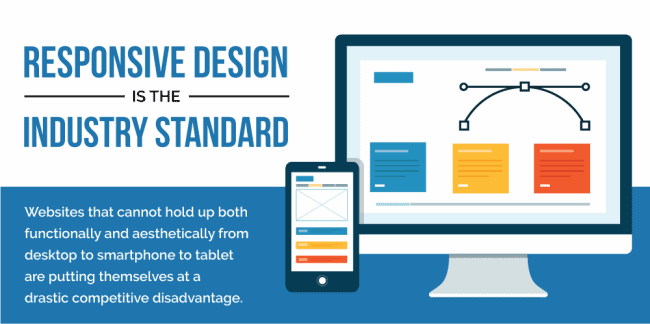You might not notice responsive design when it’s present on a website, but you definitely notice when it’s not. In our mobile-centric world, there’s an expectation that websites should function identically across devices. Responsive design utilizes a grid-based format that enables your website to – as the name suggests – respond to the screen size and orientation of a user’s device for optimal functionality and a consistent user experience.
As the trend towards mobile-first browsing continues to become the industry norm, having a website that functions seamlessly when accessed from any device is essential. Here are 10 reasons to make 2020 the year you integrate responsive design into your digital marketing strategy.
1) It’s the Industry Standard
In the year 2020, responsive design is no longer an option – it’s a necessity. We’re living in a world gone mobile, and websites that cannot hold up both functionally and aesthetically from desktop to smartphone to tablet are putting themselves at a drastic competitive disadvantage. If your website is still not designed to be responsive, make that your first priority in the new year if you want to stand a chance against your competitors who have already made this shift.
 2) It’s Cost-Effective
2) It’s Cost-Effective
Having separate websites for desktop and mobile browsing can quickly become expensive, even if the designs themselves are identical. Duplicate websites requite duplicate hosting and duplicate upkeep – all equating to duplicate costs. A responsive design website, on the other hand, only requires a single investment to be accessible to all users across all devices.
3) It Improves User Experience
No user wants to have to zoom in, wide scroll or wait for images to load in order to view your website on a mobile device. Integrating responsive design on your website, however, ensures that your website will look and behave the same way on any device in order to provide a positive user experience. The seamless functionality that responsive design offers to your website will bring a sense of professionalism and reliability to your business that likely would not come across on a difficult to navigate unresponsive site.
4) Search Engines Love It
If there are two things Google’s SEO ranking algorithm is known for, it’s rewarding mobile-optimized websites and punishing duplicate content. If your current website is not responsive, you are putting your business at risk of taking a SEO hit by not being equipped for mobile browsing while sharing copy with a separate mobile site. Making the change to responsive design, however, will satisfy both of these ranking necessities and give your website a better chance of being found in a search query.
5) It Requires Less Maintenance
If you don’t already have a responsive website, then you have a separate mobile site that also requires regular maintenance. With responsive web design, on the other hand, you can maintain all desktop and mobile updates in one place from one URL. This leads to more consistently managed maintenance that’s more cost-effective than having to maintain two separate websites.
6) It Centralizes Your Analytics
While having a single responsive website helps to centralize your maintenance upkeep, it also centralizes your analytics. Tracking duplicate websites via Google Analytics can quickly become tedious, time-consuming and overall inefficient. Responsive design enables you to review your analytics from both mobile and desktop visitor sessions, which provides a more accurate look at a variety of measures of your website’s performance across devices.
7) It Provides Flexibility
If you haven’t made the switch to a responsive website yet, your design capabilities are limited to what a separate mobile site can handle. Using responsive design grants your business a great deal of flexibility in terms of utilizing design elements that would slow down a standard mobile site, such as larger video and image files or interactive features. This flexibility enables you to create an aesthetically pleasing website that works across devices without any functionality parameters hindering the design.
8) It Keeps Your Branding Consistent
How many times have you accessed a website on your laptop, only to revisit it on your phone later? Having separate websites for desktop and mobile browsing can require some design discrepancies, which can make your branding appear inconsistent. The grid-based nature of responsive design, however, ensures a consistent experience for users no matter how they access your website.
9) It Increases Conversion Rates
A responsive website allows your business to reach a much larger audience than you would with a website only optimized for desktop browsing. More than half of consumers admit to having made an online purchase using a mobile device, and 40% use their smartphone to research a business or product prior to making a purchase. Optimizing for mobile browsing through responsive design will make it much easier for customers to shop on your site, leading to more sales and higher conversions.
 10) It Decreases Bounce Rates
10) It Decreases Bounce Rates
Your bounce rate measures the frequency at which visitors come to your website and leave immediately. Poor usability is a common cause for a high bounce rate, and a slow-loading, unresponsive design would undoubtedly deter users from exploring your website further. The user-friendliness that responsive design provides entices users to spend more time on your website, thus decreasing your bounce rate, bolstering your SEO and increasing the likelihood of closing a sale.
Make The Switch to Responsive Design
In today’s digital world, a user-friendly and mobile-friendly website is essential to business success. Still working with an unresponsive website and feeling like your business is falling behind the curve? It’s never too late to make the switch to responsive design – chat with us to learn more about how this could benefit your website, your customers, and your business in the long haul.





